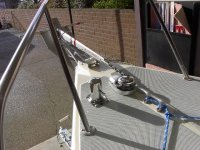colobear
New member
- Joined
- Jan 23, 2005
- Messages
- 2,154
- Reaction score
- 1
- C Dory Year
- 2006
- C Dory Model
- 22 Cruiser
Yesterday I went to the Seattle "marine garage sale" by Fisheries Supply
What a hoot, I got there at about 0645 and the place was crawling with people, some great deals (more later) and loads of "junque" much of which I couldn't even recognize.
Anyway, I am trying to outfit C-Cakes being rigged by Les at EQ and got (gloat here) an 11# genuine Bruce anchor, 10' of chain and 160' of 1/2" three strand line all of which appears to have never been in the water, for $30. My question is, here in the San Juans/Puget Sound area, is this enough for a main anchor/ rode?? I had been planning a 16.5# Bruce with a 4# Fortress as a second/spare. I expect I'll end up with another 100' or so of anchor line as everyone seems to have 200'+ But should I make the 11# Bruce the spare and get a bigger anchor for the main?
And, Les has suggested a magnetic compass is unnecessary for C-Cakes as I'll have a Raymarine C80 setup with radar and GPS. However, as an old retired Army guy/elk hunter, I feel nekkid without a magnetic compass and will probably put one in just to feel more secure. One of Les' arguments is that it is really hard to compensate a magnetic compass in a 22' with all the electronics around. Having said all that, What is the C-Brats wisdom about compasses, necessity, brand/model, and location?
Other good deals included 4 perfectly good fenders for a total of $4, PFDs,
line, etc. It was definitely worth the drive.
Barry \ Colobear
What a hoot, I got there at about 0645 and the place was crawling with people, some great deals (more later) and loads of "junque" much of which I couldn't even recognize.
Anyway, I am trying to outfit C-Cakes being rigged by Les at EQ and got (gloat here) an 11# genuine Bruce anchor, 10' of chain and 160' of 1/2" three strand line all of which appears to have never been in the water, for $30. My question is, here in the San Juans/Puget Sound area, is this enough for a main anchor/ rode?? I had been planning a 16.5# Bruce with a 4# Fortress as a second/spare. I expect I'll end up with another 100' or so of anchor line as everyone seems to have 200'+ But should I make the 11# Bruce the spare and get a bigger anchor for the main?
And, Les has suggested a magnetic compass is unnecessary for C-Cakes as I'll have a Raymarine C80 setup with radar and GPS. However, as an old retired Army guy/elk hunter, I feel nekkid without a magnetic compass and will probably put one in just to feel more secure. One of Les' arguments is that it is really hard to compensate a magnetic compass in a 22' with all the electronics around. Having said all that, What is the C-Brats wisdom about compasses, necessity, brand/model, and location?
Other good deals included 4 perfectly good fenders for a total of $4, PFDs,
line, etc. It was definitely worth the drive.
Barry \ Colobear

